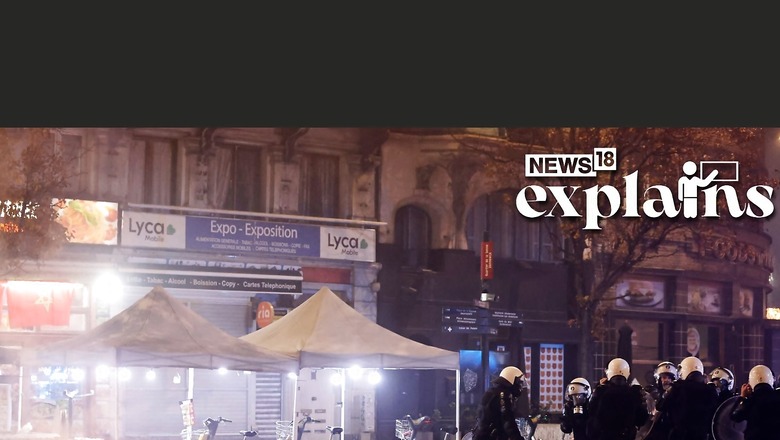
views
After the FIFA World Cup’s conclusion in Qatar, French streets did not look too happy. Gathered in celebratory anticipation, the French national team’s loss to Argentina in the World Cup final should have put a somber full stop to the cheers. But soon enough, reports broke out of rioting by football fans in various cities, including Paris.
According to the Sun, French police had to use tear gas to disperse rioting fans after Argentina’s victory, who took to the streets in large numbers across the country, with clashes reported in Lyon and Nice, as well.
Such incidents are not uncommon.
In fact, within the time frame of the Qatar World Cup, riots were seen across Europe after several games in recent weeks.
Riots had erupted in several cities across France and Belgium on December 15, after France ended Morocco’s World Cup dream run with a dominant 2-0 victory in the semi-finals.
Following the development, clashes erupted, and a 14-year-old boy was killed after being run over in the southern French city of Montpellier.
The BBC reported that the incident occurred in Montpellier’s northwestern district of La Paillade, about half an hour after France’s 2-0 victory over Morocco.
Tensions between supporters of France and Morocco had briefly flared in the city centre, with flares being lit and police responding with tear gas. There are approximately 1.5 million Moroccans in France.
But why the violence? And is it common in Football?
Kind of, and since a…while.
A report by the Social Issues Research Centre talks about the ‘violent’ origins of football, right back to the 13th century.
In England at the time, the original ‘folk’ version of the game, which was most commonly played on Shrove Tuesdays and other Holy Days, consisted of only slightly structured battles between the youth of neighbouring villages and towns.
The presence of a ball, in the form of a leather-bound inflated pig’s bladder, was almost incidental to this semi-legitimate opportunity for settling old scores, settling land disputes, and engaging in ‘manly’ tribal aggression, the report explains.
There were parallels in other European countries, such as the German Knappen and the Florentine calcio in costume, but the modern game’s roots are firmly in these ancient English traditions, it states.
These calendar rituals, which were frequently accompanied by extended bouts of drinking, frequently resulted in serious injuries and even death for the participants.
While sporadic outbursts of violence at modern football matches in Europe have almost hysterical sanction, according to the report, “our forefathers found nothing particularly strange or sinister in the game’s far bloodier origins.”
But this violent version of football violence was not universal, and there were calls for game controls as early as the 14th century.
These, the report explains, were motivated not so much by moral concerns about football’s violent consequences as by the fact that driving ordinary citizens away from market towns on match days was bad for business.
When the game spread to London and was played by rival groups of apprentices, orders were issued prohibiting the sport.
Several hundred football players were reported destroying drainage ditches and causing mayhem in the towns throughout the 17th century.
By the 18th century, the game had taken on an overtly political significance. A match in Kettering, with 500 men on each side, was a barely disguised food riot with the goal of looting a local grain store.
The game itself evolved from an unregulated battle on an ill-defined field of play to the modern rule-governed sport as a result of urbanisation and industrialisation, which corralled the traditional battlefield game into smaller and smaller arenas.
But how did the game then transport itself to a more regularised version?
According to the report, the unruliness of the pastime became a source of concern among the educators of England’s privileged sons in the arena of public schools. The older boys had complete control over the younger ‘f*gs’ and would enlist them in the game on their behalf:
“…the enemy tripped, shinned, charged with the shoulder, got you down and sat upon you…in fact might do anything short of murder to get the ball from you.”
Dr. Thomas Arnold, the headmaster at Rugby since 1828, was successful in tempering the boys’ enthusiasm for wild and brutal football.
First, he formalised the older boys’ right to power through appointments, ensuring the masters’ control over the barbaric ‘prefect-f*gging’ system. Rather than attempting to outlaw football, as previous masters had done, he legitimised it and encouraged the students to create a set of rules to govern it.
The real violence on the football field was ritualised by regulation as the fight for dominance among the students was pacified through delegation of power.
Much of the emphasis on the gentlemanly qualities of the game, as well as the evangelical promotion of the sport as an alternative to idle evils like alcohol, can be traced back to this period when the game thrived in public schools.
The newly refined and ‘respectable’ game gradually permeated the rest of society. Football was exported to the continent in this form.
However, the export of the new game in the European continent also had its cultural waves. It’s nuances and sport spirit(s) were interdivided within class boundaries, but violent disturbances were not completely rooted out.
‘Football hooliganism’ as it has come to be known, continued after the Second World War and into the 1950s, also interspersed with the politics of the age later. For example, by 1960 a ‘new form of zealous patriotism became violently directly at immigrants’.
As the report sums up: “From the 12th century to the present, the game of football has been claimed, defined, refined and reclaimed by every stratum of society. In the end, moral guardianship of the game has gone to those who shout, chant, clap and cheer the loudest for it – the supporters. How and why the current hooligan situation evolved, the sometimes violent battle for dominance on the terraces, is in itself a heated contest among social scientists.”
Read all the Latest Explainers here




















Comments
0 comment